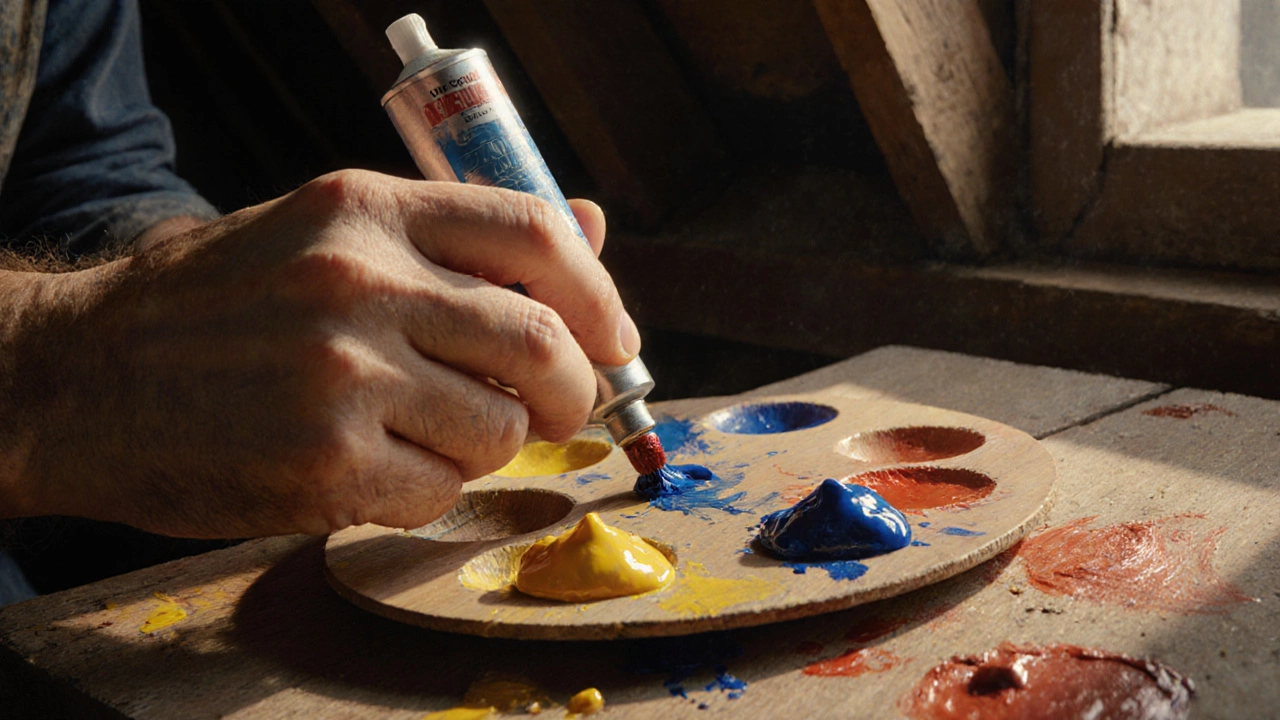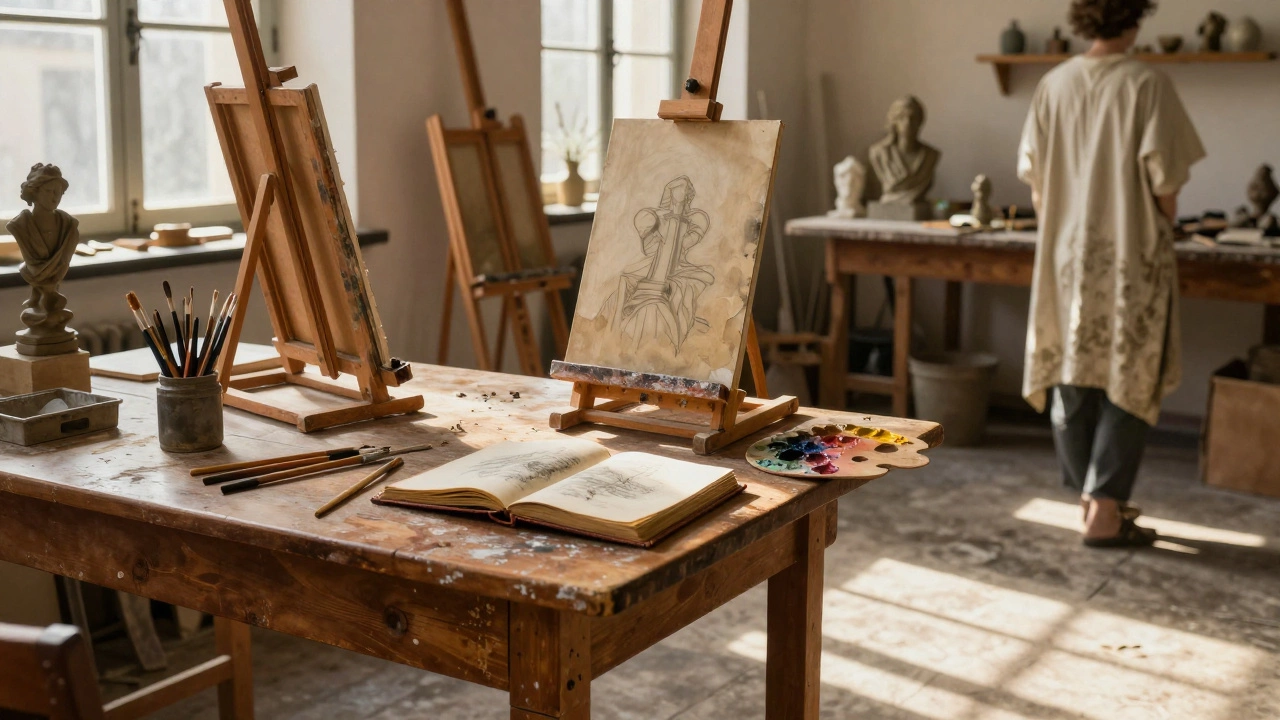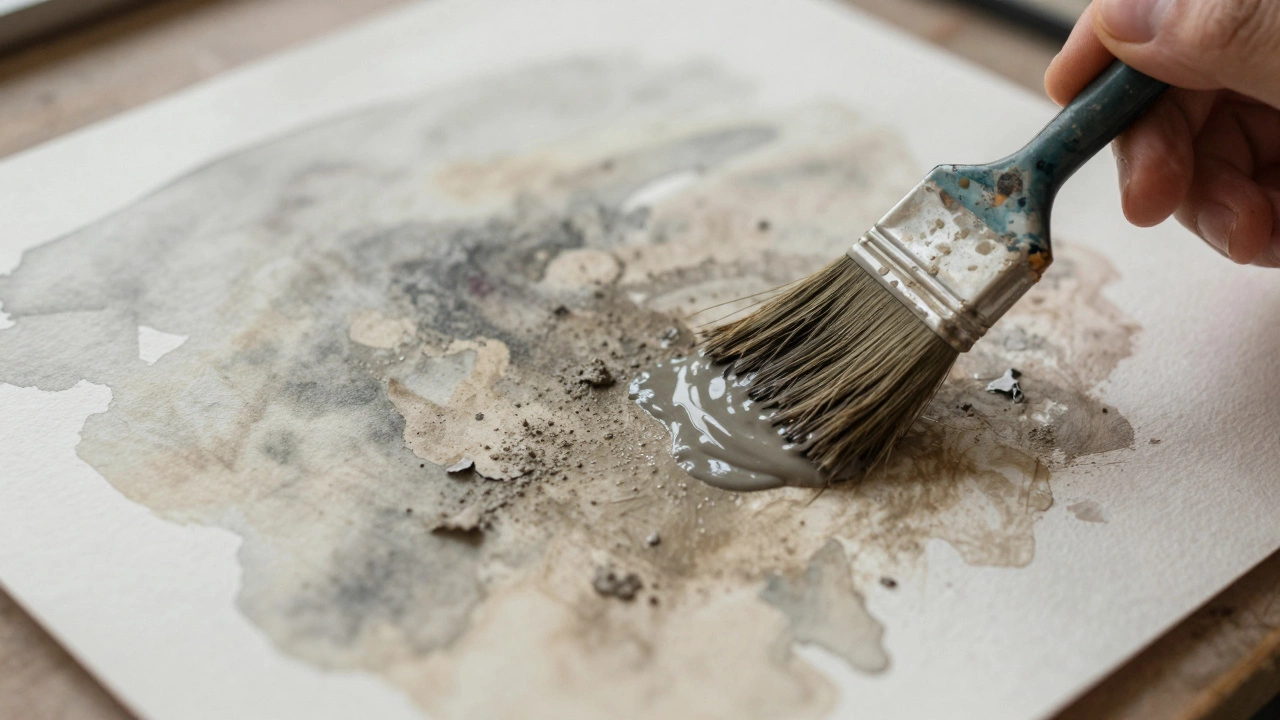Van Gogh Pigment Stability Checker
Check Pigment Stability
Select a pigment used by Van Gogh to see if it's stable over time and get modern alternatives.
Why This Happens
Van Gogh didn’t just paint with oil-he built emotion with it. His swirling skies, blazing sunflowers, and trembling cypress trees weren’t just brushstrokes; they were made from pigments that didn’t exist a century before. If you’ve ever stood in front of The Starry Night and felt the wind in the stars, you’re sensing the physical presence of cadmium yellow, cobalt blue, and vermilion-materials he mixed, squeezed, and smeared onto canvas with his bare hands.
The Pigments in Van Gogh’s Palette
Van Gogh’s oil paints weren’t just any colors. They were newly available synthetic pigments that had just hit the market in the mid-1800s. Before then, artists mixed their own paints from ground minerals and organic materials. Van Gogh, like many of his contemporaries, took full advantage of the industrial revolution’s impact on art supplies.
His most-used colors included:
- Cadmium Yellow - Used in nearly every sunflower painting. Bright, opaque, and stable, it replaced the toxic but fading orpiment.
- Cobalt Blue - His go-to for skies and shadows. Less expensive than ultramarine, but just as vivid.
- Chrome Yellow - Found in the wheat fields of Arles. Later, this pigment darkened over time, which is why some of his yellows now look brownish.
- Verdigris - A green made from copper acetate. Used in landscapes, but it’s chemically unstable and often turned brown.
- Emperor’s Purple (Manganese Violet) - A new synthetic pigment at the time. Van Gogh used it in his self-portraits and night scenes to create depth without using black.
- Lead White - The base for nearly all his light tones. Toxic, but the only reliable white available.
- Vermilion - A mercury-based red. Used for lips, accents, and the reds in his bedroom series.
He didn’t use black. Not once. Not even in shadows. Instead, he mixed complementary colors-like cobalt blue and burnt sienna-to create deep tones. This gave his paintings a luminous quality that flat black could never achieve.
How He Got His Paints
Van Gogh bought his paints from local art suppliers in Paris, Arles, and Saint-Rémy. He wrote letters to his brother Theo asking for specific brands: LeFranc & Bourgeois in Paris, and Hardy in Arles. These were the major French manufacturers of the time, and they sold oil paints in metal tubes-a relatively new invention.
Before tubes, artists had to grind pigments by hand and store them in pig bladders. Tubes changed everything. They kept paint fresh, portable, and ready to use. Van Gogh carried his tubes in a small box and painted outdoors, often in the same spot for hours. He once wrote: “I work as fast as I can, like a man who is in a hurry to catch the train.” The tubes made that possible.
Why Some Colors Changed Over Time
Not all of Van Gogh’s colors stayed true. Some faded. Others darkened. Chrome Yellow, for example, was prone to chemical breakdown when exposed to light. In paintings like Field with Irises near Arles, the once-bright yellow fields now look dull and brown. Scientists at the Van Gogh Museum used X-ray fluorescence to confirm that the chrome pigment had degraded into chromium(III) oxide.
Verdigris, the green pigment he loved, turned brown in many landscapes. He used it heavily in his cypress trees and hills, but over 130 years, the copper in the paint reacted with moisture and air. Today, restorers can’t bring back the original green without risking damage to the paint layer.
Lead White, on the other hand, held up perfectly. It’s still bright in his 1889 self-portrait. That’s because lead oxide is chemically stable-unlike the newer, flashier pigments he was experimenting with.
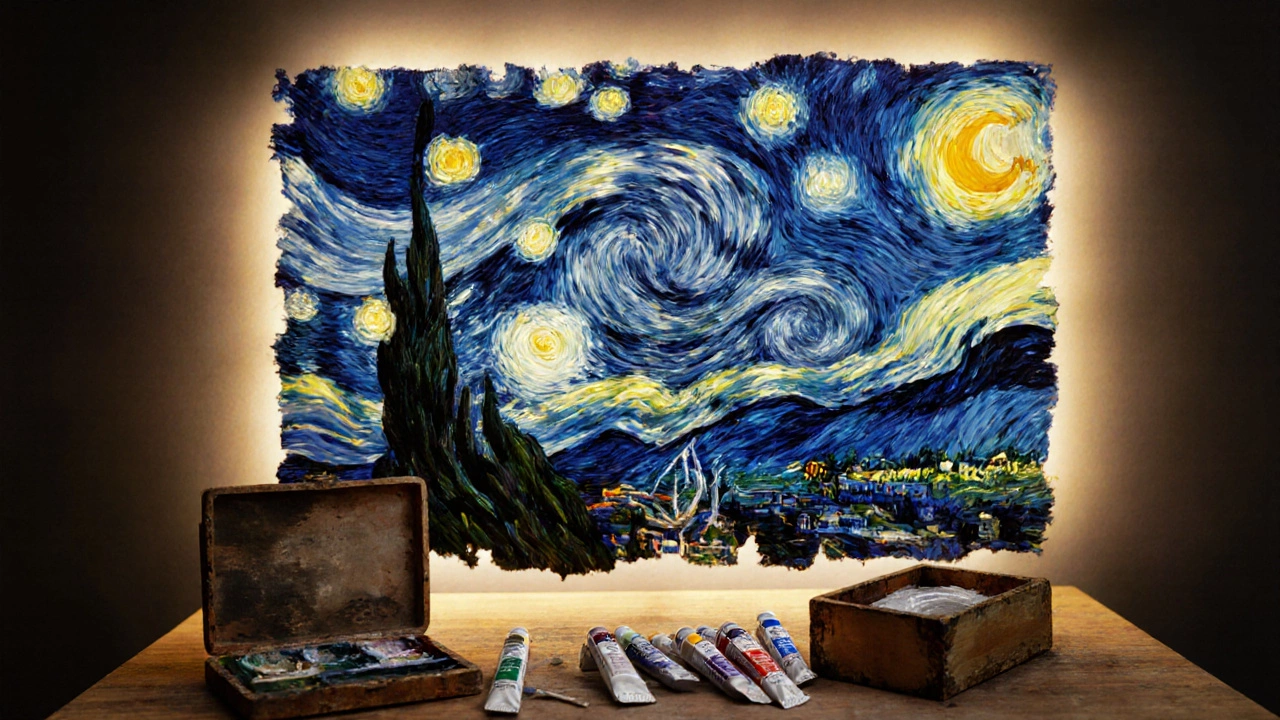
What Modern Paints Are Closest to His?
If you want to paint like Van Gogh today, you don’t need to hunt down 19th-century tubes. But you do need to choose wisely.
Modern artists who recreate his palette use:
- Cadmium Yellow Medium - The closest match to his original hue.
- Cobalt Blue - Still made the same way. No substitute.
- Pyrenees Yellow (a modern chrome yellow replacement) - Less likely to darken.
- Manganese Violet - Still available under brands like Winsor & Newton and Talens.
- Lead White is banned - Use Titanium White instead, but mix a tiny bit of yellow into it to match Van Gogh’s warmer tones.
One key detail: Van Gogh never mixed his colors on the palette. He applied them straight from the tube, side by side, letting them blend on the canvas. That’s why his brushwork has such energy. Modern painters who try to replicate his style often over-mix, killing the vibrancy.
His Paintings Are a Time Capsule
Van Gogh’s oil paints are more than just color-they’re a record of his life. He used the same tube of cadmium yellow in both his Arles sunflowers and his Parisian self-portraits. He reused the same cobalt blue in the sky above the wheat fields and the walls of his asylum room.
Scientists have mapped his pigment use by painting location and date. In 2021, researchers from the University of Amsterdam analyzed 175 of his works and found a clear pattern: the more he struggled emotionally, the more he used high-contrast, saturated colors. In Saint-Rémy, when he was in crisis, he painted with more vermilion and cobalt blue. When he was calm, he used softer earth tones.
His paints didn’t just show what he saw-they showed how he felt.
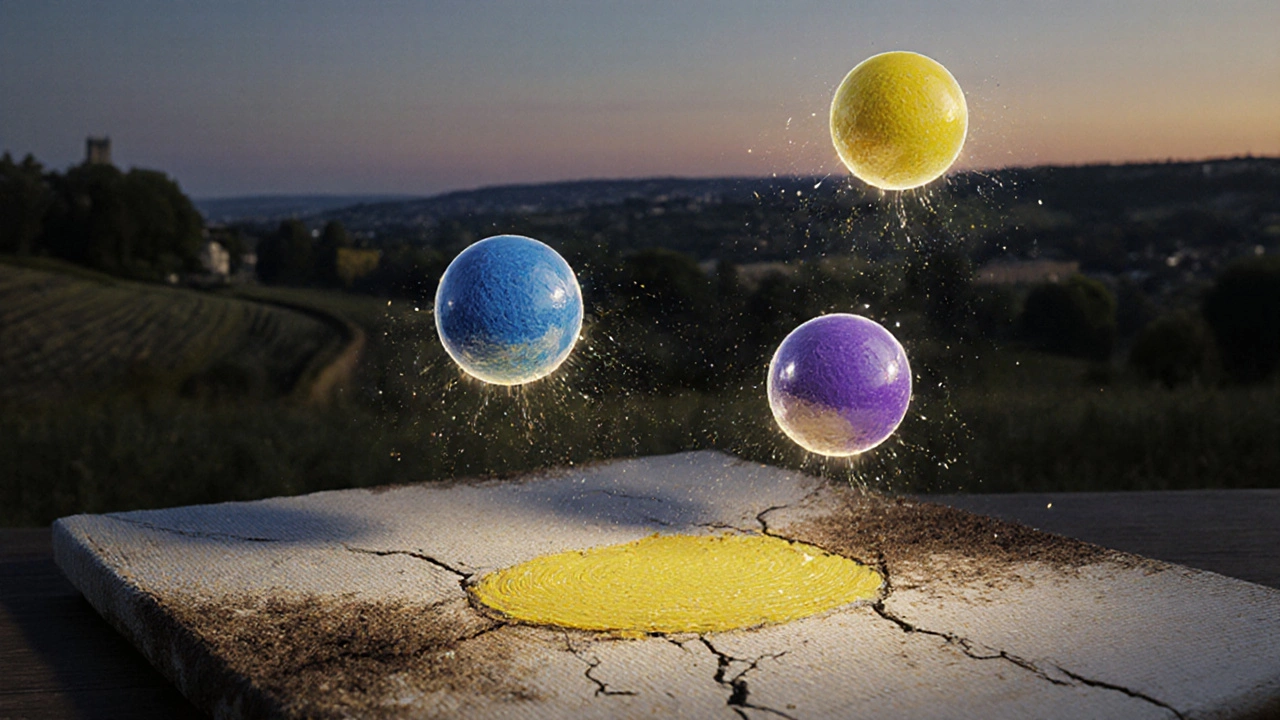
What You Can Learn From His Choices
If you’re an artist trying to understand Van Gogh’s technique, it’s not just about copying his brushstrokes. It’s about understanding his materials.
- Use pure, unmixed colors straight from the tube.
- Never use black. Mix darks with complements.
- Choose stable pigments-avoid chrome yellow if you want your painting to last.
- Let the texture of the paint show. Van Gogh used thick impasto-sometimes so thick you can see the ridges of his brush.
- Paint quickly. He worked in one sitting when possible.
He didn’t paint for galleries. He painted because he had to. And he used the tools he had-bright, new, imperfect paints-to say what words couldn’t.
Did Van Gogh use oil paint or watercolor?
Van Gogh primarily used oil paint for his most famous works. He did create over 150 watercolor sketches, especially during his early years in the Netherlands and during travel, but these were studies, not finished pieces. His major paintings-like The Starry Night, Sunflowers, and Irises-are all oil on canvas. Watercolor was for practice, not exhibition.
Why do Van Gogh’s yellow paintings look brown now?
The yellow paint he used-chrome yellow-contains lead chromate, which breaks down under UV light over time. This chemical reaction turns the bright yellow into a dull brown or olive tone. Paintings like Field with Irises near Arles and The Yellow House have visibly changed. Museums now control lighting to slow this process, but the damage is irreversible.
Did Van Gogh mix his own paints?
No. Van Gogh bought his paints ready-made in metal tubes from commercial suppliers like LeFranc & Bourgeois and Hardy. He didn’t grind pigments himself. This was common for artists by the 1880s. What he did mix was the color on the canvas-not on the palette. He applied pure colors side by side to create optical blending.
What’s the most important color in Van Gogh’s work?
Cadmium yellow is arguably the most important. It appears in nearly every major work from his Arles period: sunflowers, wheat fields, his bedroom, and even the sky in The Starry Night. It was his emotional anchor-a color he associated with hope, energy, and light. He wrote to Theo that yellow was the color of the sun, and the sun was his inspiration.
Can I buy Van Gogh’s exact paints today?
You can’t buy the exact same tubes-he used paints made in the 1880s that are no longer produced. But modern brands like Winsor & Newton, Talens, and Old Holland offer pigments that match his palette closely. Look for cadmium yellow medium, cobalt blue, manganese violet, and titanium white (with a touch of yellow to warm it). Avoid modern chrome yellows-they’re still unstable. Use pyrenees yellow instead.
Final Thought: Paint as a Language
Van Gogh didn’t paint to be famous. He painted because he needed to speak. And the language he chose was made of cadmium, cobalt, and lead. His colors weren’t just pigments-they were his voice. When he pressed thick strokes of yellow onto canvas, he wasn’t just painting a field. He was shouting into the silence.
Today, those same paints still speak. If you look closely at a Van Gogh original, you can still feel the pressure of his fingers squeezing the tube. You can still hear the scrape of his brush. You can still see the light he fought to capture-and the color he refused to let fade.
